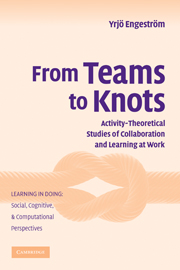Book contents
- Frontmatter
- Contents
- Series Foreword
- Preface
- 1 Teams and the Transformation of Work
- 2 Disturbance Management and Masking in a Television Production Team
- 3 Teamwork between Adversaries: Coordination, Cooperation, and Communication in a Court Trial
- 4 Displacement and Innovation in Primary Care Medical Teams
- 5 Crossing Boundaries in Teacher Teams
- 6 Knowledge Creation in Industrial Work Teams
- 7 Teams, Infrastructures, and Social Capital
- 8 From Iron Cages to Webs on the Wind
- 9 Knotworking and Agency in Fluid Organizational Fields
- References
- Author Index
- Subject Index
- Titles in the series
1 - Teams and the Transformation of Work
Published online by Cambridge University Press: 05 June 2012
- Frontmatter
- Contents
- Series Foreword
- Preface
- 1 Teams and the Transformation of Work
- 2 Disturbance Management and Masking in a Television Production Team
- 3 Teamwork between Adversaries: Coordination, Cooperation, and Communication in a Court Trial
- 4 Displacement and Innovation in Primary Care Medical Teams
- 5 Crossing Boundaries in Teacher Teams
- 6 Knowledge Creation in Industrial Work Teams
- 7 Teams, Infrastructures, and Social Capital
- 8 From Iron Cages to Webs on the Wind
- 9 Knotworking and Agency in Fluid Organizational Fields
- References
- Author Index
- Subject Index
- Titles in the series
Summary
Teams as a Puzzle
In 1995, my research group began to follow and videotape three adjacent work teams in a large manufacturing plant in California specializing in high-precision machining. The company was well underway in its efforts to organize its entire workforce into self-directed teams. The transition was a carefully planned strategy that was to take place over a period of several years. It was supported by some of the most prominent consultants in the field. The company gave its teams a great deal of training, and it had produced an impressive guidebook for the teams. The guidebook gave the following definition of work teams:
A work team is an ongoing team which uses the talents and skills of various employees in the accomplishment of work (such as product, sub-assemblies, or service) on a routine basis to achieve common goals and shared vision.
The guidebook defined 12 responsibilities of work teams, ranging from “solve quality problems to achieve and maintain customer satisfaction” to “manage their own budget” and “give and receive on-going performance feedback.”
As we started observing the teams, the largest one was meeting on a weekly basis and making important production-related decisions. The meetings were lively, tensions between perspectives were displayed and resolved, and innovative ideas were produced (an analysis of these early meetings is presented in Chapter 6).
Within 6 months, this most dynamic team stopped having meetings. Its last meetings were marked by an atmosphere of resignation and disappointment.
- Type
- Chapter
- Information
- From Teams to KnotsActivity-Theoretical Studies of Collaboration and Learning at Work, pp. 1 - 21Publisher: Cambridge University PressPrint publication year: 2008



